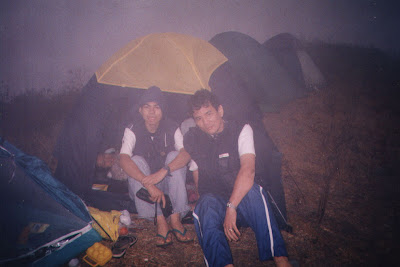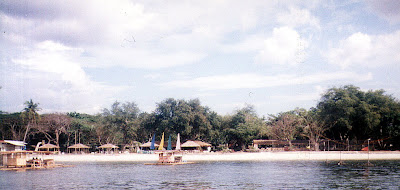Lakbay Kalikasan, Southeast Asia’s first and premier outbound education outfitter, embarked on a series of outbound education demonstration tours for teachers from other schools willing to try out their outbound education programs and they invited me to cover one of these tours that promote appreciation of the living remnants of a pre-Hispanic tradition which is still being practiced today in Mt. Banahaw, that of worshiping nature (rivers, mountains, old trees and fields) in the belief that such natural objects were the habitats of spirits. Jesu-Mariae School, my son Jandy’s school, joined the tour and they were represented by Robert “Rob” V. Castañeda and Eleser “Ely” Borero.
 |
| Hiking up Calvario |
Our destination was Mt. Banahaw’s Brgy. Sta. Lucia Complex 1 in Dolores (Quezon), one of Banahaw’s 4 complexes – the others being Kinabuhayan (Resurrection), Durungawan (Window) and Ilalim (Crater), which lies at the foot of the 1,470-m. high Mt. Cristobal. We left the EDSA Shrine (our assembly place) by 5:30 AM, April 9 (Bataan Day), on board one of two vans. Joining us were 16 other teachers from 6 Metro Manila schools (Augustinian Abbey School, Madre Pia, Miriam College, Olivarez College, St. Benedict and Santa Catalina High School). Our Lakbay Kalikasan hosts were Mr. Ramon Jocson (Corps Director), Mr. Ronaldo Dalofin (Team Leader/Lecturer 2), Mr. Roger Quizol (Team Leader 2), Mr. Oscar Orbe (Team Leader 3) and Ms. Billy de la Cruz (Facilitator 3). The trip to Dolores was to take all of 3 hours.
Upon arrival at Sta. Lucia, we visited the compound of the Suprema Iglesia del Ciudad Mystica del Dios, Inc. (Supreme Church of the Mystic City of God), the largest of Banahaw’s 66 to 88 registered colorums, entering it via a huge 20-foot high stainless steel gate. The word colorum is derived from the Latin Mass invocation in saecula saeculorum. These esoteric folk Christian religious communities, varying in size from several thousand members to a few adherents, believed that Mt. Banahaw is the site of the Holy Land and that Christ walked in the area. They also share an intense nationalism and reverence for National Hero Jose Rizal who is considered a demigod or the Tagalog Jesus Christ. Many sects also believe in the ascendancy of the female (Ciudad Mystica included) and women, rather than men, perform the priestly functions. These religious sects around Dolores resent the kulto (cult) connotation insinuated by non-believers.
Mt. Banahaw is full of sacred natural shrines locally called puwestos (places), all said to have been discovered by Katipunero Agripino Lontok, and one of our objectives was to undergo and relive the pre-Hispanic tradition of pamumuwesto (spiritual pilgrimage) by hiking, crossing rivers and entering caves, all sacred destinations with deep historical and symbolical meanings, communing with the spirits for paglilinaw (discernment) and paglilinis ng loob (inner cleansing) so that we may take the challenges ahead. Along the way, lectures and meditations are intermittently given and, in all puwestos, candles are always lit.
 |
| My baptism |
We descended, down a gorge, to Sta. Lucia Falls, fed by the cool Lagnas (or Kinabuhayan) River, and Piedra Mental, a stone altar where pilgrims pray for mental discernment as they go through the pamumuwesto. At the stream which courses down Banahaw (also called Ilog ng Jordan, alluding to John the Baptist’s baptism of Christ), we “cleansed” or “purified” (water is a universal archetype for cleansing) ourselves and drank the sulfuric waters of the falls 3 times (symbolic of the Triune God – the Father, the Son and the Holy Spirit) prior to our entering the sacred caves (kuweba), the pilgrim’s church. After our ritual baptism, we we then climbed up the steep gorge.
 |
| One of many caves in Sta. Lucia Complex |
At the huge boulder of Kaban ni San Isidro, the gate to the entire complex of Sto. Kalbaryo, we lighted candles and said a short prayer for safety and guidance, while at the book-shaped boulder called Aklat ng Buhay (the Book of Life said to contain our names, date of birth and even date of death) at Prisintahan , we imaginatively “register” our names and those of our loved ones. A real hurdle was the 40-m. long Santong Husgado (Holy Judge), one of the caves at Ina ng Awa revered by the religious sects and given Biblical names. Said to test the purity of those who enter, it is believed that when you get out of this cave, 7 years of your sins will be forgiven but, if you are not completely malinis (cleansed), you will be trapped inside.
 |
| Santong Husgado |
We had to hike, barefoot, from Ina ng Awa to the cave opening (with lit candles strategically placed along the cave), carrying just the clothes on our back. The ladies, with their small frames, decided to go in first. I was the last to enter this “cave” which was more of a rabbit hole. All the while, I was figuring out how to get my 5’-10,” 188-pound frame inside that hole. Ready and willing for this test of faith (pagsubok), I kept remembering the familiar Biblical proverb “I can do anything through Christ who strengthens me” (Philippians 4:13). Crawling through it entailed a lot of body contorting as well as decision-making. “Should I enter head or feet first?” “Should I do it on my stomach or on my back?” Finally, after what seemed like an eternity of struggle, I finally made it out to Ina ng Awa. Now I know how a worm feels. I, together with the others, were all mud-splattered yet, surprisingly, our habit-cladded sister colleague from Madre Pia was still spotlessly clean. Could it be divine intervention? I wonder.
Lakbay Kalikasan: G/F Balai Lakbay, 2 Alondras St., Mira-Nila Homes, Tandang Sora Ave., Quezon City, Metro Manila. Tel: (632) 932-7818 to 19. Mobile number: (0917) 500-4796. Website: www.lakbaykalikasan.com.


























.jpg)




.jpg)




















